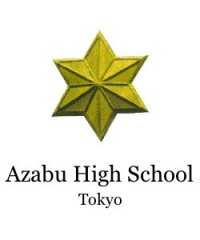Azabu High School
| Azabu High School | |
|---|---|
 | |
| Location | |
| Moto-Azabu, Minato, Tokyo, Japan | |
| Information | |
| Type | Private School |
| Established | 1895 |
| Founder | Soroku Ebara |
| Principal | Hideaki Taira |
| Faculty | 100 |
| Grades | 7 - 12 |
| Gender | Male |
| Enrollment | 1800 |
| Major(s) | Liberal Arts |
| Website | http://www.azabu-jh.ed.jp/English/azabuhighschool.htm |
Azabu High School (麻布高等学校 Azabu Kōtōgakkō), referred to as "Azabu" by most, is a private preparatory day school in Japan. It teaches boys between seventh and twelves grades. The campus of Azabu is located in the Azabu district of Minato, Tokyo, Japan. Azabu High School technically consists of two institutions, which are Azabu Junior and Senior High Schools (麻布中学校・高等学校 Azabu Chūgakkō Kōtōgakkō), the former teaches pupils between seventh and ninth grades while the latter teaches pupils between tenth and twelves grades.
Azabu is one of the most prestigious preparatory schools in Japan, and perhaps most widely known as a member of "The Three Houses for Boys," along with Kaisei Academy and Musashi Junior & Senior High School. The school has been sending approximately one third of its graduates to the most prestigious university in Japan, University of Tokyo. Unlike other academically distinguished schools (including Kaisei Academy), the traditions at Azabu are liberal and magnanimous. For example, there are no established school rules that students are required to adhere, and there is no "study-compelling" atmosphere.
History
Azabu started its history as Middle School at Toyo Eiwa School in 1884. The school was founded by Ebara Soroku, a Japanese educator in the transitional period of Japan, and the President of Toyo Eiwa School at that time. The school was not initially accredited but gained its initial accreditation in 1895. Gaining its name as Azabu Ordinary Middle School, Azabu decided to relocate to the current location as Toyo Eiwa Theological Seminary, where Azabu was holding classes, was driven into permanent closure due to low enrollment. In 1890, the relocation occurred and the school received a new name, Azabu Middle School. After the World War II, the school was reformed to meet new regulations, and two institutions, Azabu Junior and Senior High Schools, were established. Although they're technically separate entities, Azabu has been run as a single school which teaches pupils between seventh and twelves grades. During the long history of Azabu, it maintained its prestige as an academically distinguished institution. The school also remembers numerous historical events (which are not necessarily positive) including Sagami Lake Incident, and School Disputes.
Present
Azabu teaches boys between seventh and twelves grades, and admits 300 students each year. Admission is extremely competitive and offers of admission are extended only to pupils with excellent reference letters and those showed extraordinary critical thinking through written exams in Japanese, Mathematics, Science, and Social Science. These written exams are typically conducted on the first day of February yearly on Azabu's campus. There are over 100 teachers and about 1,800 students in total. The school festival, which usually takes place from third to fifth of May, is one of the largest in Japanese high schools, with over 20,000 people attending each year. The athletic meet is held in October. There are nearly 50 clubs, and the chess club, the othello club, the go club, and the shogi club are especially well known for their extraordinary achievements, which includes winning the all-Japan championships almost every year. The clubs (often referred to as “circles” in the school), the school festival, and the athletic meet are all planned and organized by the students without any help from faculty members. Azabu is also active in international exchange programs: there currently are exchange programs with Shawnigan Lake School in Canada, Winchester College in UK, and Ningbo Polytechnic in People's Republic of China. Nobuhiro Hikami, Professor of Philosophy, serves as the principal of the school today.
Location/facility
The school is located in the Azabu district (the origin of the school name) which is an area in the Minato Ward, and the nearest train station is Hiroo Station (Tokyo Metro Hibiya Line). The Azabu district is mostly a residential area, and the main gate of the school is so narrow that one may not notice that there is a large school there. This fact produced the famous phrase "Azabu’s narrow gates," which also implies its extremely competitive admission policy.
The classrooms are located in the main building, which is a square-shaped, 4-story building with a courtyard. The courtyard can also be used as two tennis courts. In 1995, a building commemorating the 100th anniversary was constructed. That building houses the school's library and some club rooms. The number of books in the library is over 40,000, which is a fairly large number for a high school library.
The schoolyard has a 200-meter track (which is also a soccer field), four volleyball courts, two more tennis courts and a 25-meter pool.
Notable alumni
This is an incomplete list of notable alumni of Azabu.
- Ryutaro Hashimoto, Prime Minister of Japan
- Yasuo Fukuda, Prime Minister of Japan
- Shoichi Nakagawa, Minister of Agriculture
- Sadakazu Tanigaki, Minister of Justice
- Chief Cabinet Secretary Kaoru Yosano
- Yoshiaki Tsutsumi, president of Seibu Railway, former wealthiest person in the world
- Takeo Fukui, President and CEO of Honda Motor Co., Ltd.
- Atsushi Furukawa, Chairperson, Microsoft Japan
- Yoshiro Nakamatsu, inventor
- Morio Kita, novelist
- Iou Kuroda, manga artist
- Takashi Yuasa, international lawyer, commentator
- Hidekatsu Shibata, voice actor (grad. 1955)
References
- "Azabu's 100 Years" / 『麻布学園の100年』 Distributed by Azabu High/Junior High School
External links
Coordinates: 35°39′15″N 139°43′40″E / 35.65411°N 139.727726°E